Picking new vehicle now has expanded scope

Sporty SUV is Infiniti QX-30 in foreground; sleek sports coupe is Lexus RC350 left rear; latest version of hot hatchback is Volkswagen Golf R, upper right.
By John Gilbert
A Volkswagen Golf showed up for a test-drive, but not just a Golf. In fact, not just a GTI. It was the Golf R, a Golf bristling with high-performance stuff that makes it the most dynamic and impressive member of the Golf family. At the same time, our driveway was graced by the presence of one of my favorite compact crossover SUVs — an Infiniti QX30 Sport.
Also, there was a Lexus, but not just a Lexus. It was a Lexus RC350. If you’re not up on the alphabet-soup of car-talk, this is a beautiful coupe, that could easily pass for an exotic sports car costing twice as much.
The biggest challenge I had for the week was deciding which car to be driving at any particular moment. I drove one up to the Duluth Farmer’s Market on 14th Ave. East and 3rd Street. A good friend and I were talking, and he knows I’m road-testing new cars every week, so he said: “If you had $50,000 to spend on a car right now, what would you buy?”
The question caught me off-guard, and I found it really difficult to answer, simply because there are so many fantastic vehicles available right now. Many, in fact, are well under his $50,000 price ceiling. So I rattled off a list of a half-dozen cars I really like, and a half-dozen compact SUVs that I wouldn’t hesitate to buy, and then a handful of impressive sporty coupes that I’d love to have.

Infiniti’s smallest and sleekest SUV is the QX-30, with a potent but economical 2.0-liter 4 cylinder and paddle shifters.
But I couldn’t get the question out of my mind as I returned home. Then I glanced out of my window toward our little turnaround area at the end of our driveway. By sheer chance, two auto distribution agencies had delivered to me three different vehicles for a week, and it was my challenge to hop back and forth to get into all of them adequately in order to give them fair evaluations.
What was interesting is all three of them were distinctly different, in distinctly different segments of the auto market, and all just happened to fall into the $40,000 to just under-$50,000 price range. Exactly what my friend was asking about.
So while it’s fun to compare several small SUVs, or large SUVs, or sporty coupes, or sedans, against each other, for a timely change of pace, here are three vehicles that all might be worthy of consideration, even though their objectives are worlds apart.
If you want a small crossover SUV, the Infiniti QX30 is among my favorites. It is low and sporty, with curves and contours built into the side styling, and it looks both distinctive and sporty and almost lets you overlook that it’s actually an SUV.
The QX-30 is both mild and hot with its 2.0-liter turbocharged 4, depending on how you drive it. Just be prepared to feel as though you’re driving a sports car the way it deftly handles any turn or quick reacting situation. This one had a list price of $38,500, but with the Sport package and other options it listed at $43,660.
This was a 2018 model, and the Sport technology package includes blind-spot detection, lane-departure warning, forward emergency braking, and a panoramic sunroof, which Nissan — or at least its Infiniti upgrade arm — prefers to call a moonroof.
The QX30 Sport comes with the intriguing new 2.0-liter 4-cylinder turbocharged engine that was designed by Mercedes Benz and built for both companies by Nissan. In the QX30, it develops 208 horsepower and 258 foot-pounds of torque, running through a 7-speed dual-clutch transmisison with steering wheel paddles.
You can click a console control knob to Eco, Normal, or Sport modes and immediately feel the difference in how firm the suspension is and how crisp or softened the steering becomes. Fuel figures from the EPA are 24 city and 33 highway, but there is one thing about this particular model: It is front-wheel drive. With the sport suspension and steering, you feel as though it could conquer any challenge, but when winter hits on the Duluth hillside, AWD is a welcome addition. But at least with the QX30, the 2-wheel drive is front-wheel drive, so it should scamper up the hills if you put the right tires on it.
One thing I didn’t like about the car was that as precise as the 7-speed automatic was, the console shift lever could be pushed forward to go past neutral to reverse…but that’s it. In a hurry, you might start to jump out and not realize you’ve left the gear in reverse until it rolls backwards. Perhaps into the bay. There is a small push button on the face of the console, and you must push it down to engage park. And then you’d better check the instrument panel to make sure it’s engaged. That’s a very German trick, but why must we be issued fantastic new cars with ambiguous and counter-intuitive trick settings just to find park?
If you always wanted to have an exotic sports car, the Lexus RC350 could be a prime candidate. It looks the part, with the signature spindle grille up front, and some slick aerodynamic vents and contours around the lights and the front corners, and same in the rear, where the dual exhausts look extra meaningful because of the styling.
This Lexus RC350 has a 3.5-liter V6 engine with dual overhead camshafts and Toyota’s new combination direct and port injection. It has an 8-speed automatic with paddles, and the 306 horsepower and 277 foot-pounds of torque are readily distributed to the raod.
The RC350 has settings on the console for Eco, normal, sport and snow — does this sound like a high-tech pattern from our Japanese designing friends? It has a potent Disney sound system, and LED headlights and a rear camera.
List price is $43,010, and as equipped it lists for $48,289. No question, you are paying something for the looks of the car. There are sports cars and there are exotic sports cars, but this is one that looks like an exotic car but is priced more with mainstream sporty cars. And it is a genuine coupe, with adequate rear head and legroom, once you’ve gymnastics-like found your way into the rear seat.
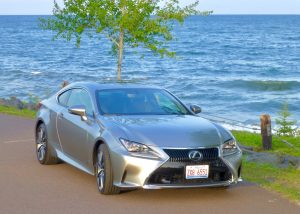
Whether boulevard cruising or on a trip to the North Shore of Lake Superior, the RC350 handles the task.
Here’s an interesting fact about the RC350: It, too, is 2-wheel drive, and the 2 drive wheels are at the rear. But you can pay a bit extra and get all-wheel drive. In Minnesota, that makes great sense. But at least it’s available. You also can get a lower-priced coupe with a 4-cylinder engine, or you could go truly hot and get the 5.0-liter V8.
Then there is the plainest-looking car of the trio, the Golf R. That little silver “R” on the grille and elsewhere stand out to those who are into cars. At a glance, it looks like the garden-variety Golf, and there’s nothing wrong with that because Golfs are solid, substantial and safe vehicles that can keep your family safe and secure.
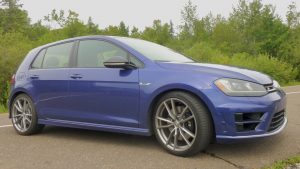
Part of the Golf’s charm is how it retains familiarity while adding technology. The R has all-wheel drive and a turbo.
The R, however, beefs up the suspension, wheels, tires, brakes — and the drivetrain. The familiar 2.0-liter 4-cylinder puts out 210 or 220 horsepower, but the R delivers 292 horsepower and 280 foot-pounds of torque, turning the Golf from a solid and efficient performer to a screamer.
And, the Golf R comes with the latest “4-Motion” all-wheel drive system from VW. Yes, while the Infiniti QX30 and the Lexus RC350 both are available with AWD, nobody expects the Golf to offer it, and have it. The GTI has always been VW’s hottest Golf, and it still is an excellent “pocket rocket,” but now it has to bow to the R.
The test Golf R passed up the optional 6-speed or 7-speed twin-clutch automatic transmissions to go with the basic 6-speed manual. Imagine a Golf with firm suspension, a lively 292 horsepower under the hood, and all-wheel drive!
Basic Golfs start at around $21,000, but you have to pay for the R. The test car showed a base price of $38,480, and as tested it was $40,195. But undersstand, that includes the special engine, transmission, dynamic chassis control with adaptive suspension and a driving mode button to alter the firmness, plus such amenities as bi-xenon lights, rain-sensing front wipers with heated nozzles, all the stability control devices, as well as adaptive crise, a Fender audio, and all the latest connectivity devices.
Interesting, the Golf R is the surprise of the group, because it comes with the leading-edge technology you are more likely to expect from the more exotic Lexus or Infiniti models.
The 4-door Golf body is forever being refined stylewise, but one thing remains the same: It is build around actual human adults, two of which can sit in comfort in the rear seats while still leaving a surprising amount of storage space under the hatch.
That doesn’t mean I’m picking the Golf R over the Lexus RC350 or the Infiniti QX30. Just another viewpoint. Add AWD to the Lexus and Infiniti and the decision would be all that much tougher.


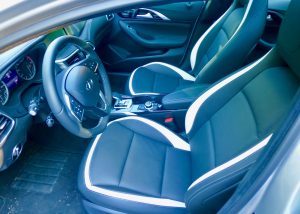
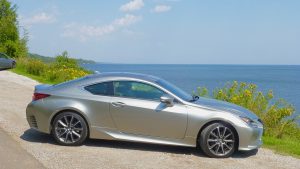
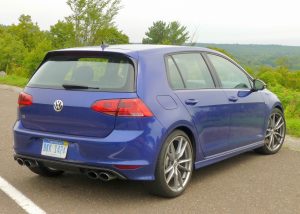
 John Gilbert is a lifetime Minnesotan and career journalist, specializing in cars and sports during and since spending 30 years at the Minneapolis Tribune, now the Star Tribune. More recently, he has continued translating the high-tech world of autos and sharing his passionate insights as a freelance writer/photographer/broadcaster. A member of the prestigious North American Car and Truck of the Year jury since 1993. John can be heard Monday-Friday from 9-11am on 610 KDAL(www.kdal610.com) on the "John Gilbert Show," and writes a column in the Duluth Reader.
John Gilbert is a lifetime Minnesotan and career journalist, specializing in cars and sports during and since spending 30 years at the Minneapolis Tribune, now the Star Tribune. More recently, he has continued translating the high-tech world of autos and sharing his passionate insights as a freelance writer/photographer/broadcaster. A member of the prestigious North American Car and Truck of the Year jury since 1993. John can be heard Monday-Friday from 9-11am on 610 KDAL(www.kdal610.com) on the "John Gilbert Show," and writes a column in the Duluth Reader.